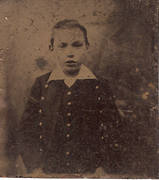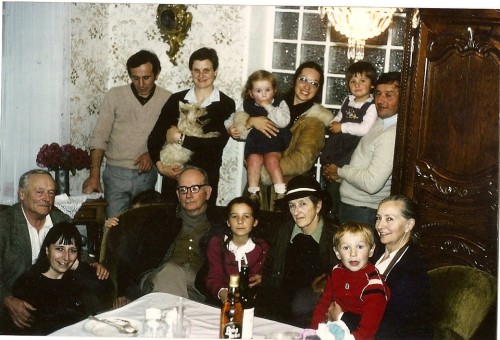From page 1, Vol. 1 of “Jules & Paul de Launay” (publish 1983) by Jules Richard de Launay. The photos which I have added are from my mother, Rosemarie’s collection.
Mes excuses. Je vais imprimer les Français de cet article bientôt.
“On the ninth of December 1813 in Paris, at the church of St. Denis du St. Denis du St. Sacrament, was baptized a two day old baby, Jules. He was the son of Jacques Launay and his wife Marie Valpinçon, living at No. 8 rue Neuve St. Catherine (now Rue des Francs-Bourgeois, Paris III). The godmother was Anne Valpinçon, wife of Boissière, residing at no. 30 Rue de la Barillerie (now Bvd. du Palais Paris I & IV). The godfather was Jules Valpinçon of No. 11 Rue des Deux Boules (Paris I).
I first obtained a copy of the certificate of baptisms of the above Jules in 1933. I knew something about my grandfather Jules, but I knew nothing of the family except for the little bit of confused information which my father Paul could remember from his conversations with his father Jules.
Since Jules died when his son Paul was only 13 & 1/2 years old, the latter’s knowledge was rather vague. The information which Paul got from his mother Anna was unreliable as she was a social-climber and gave herself and her husband Jules grand (but false) ancestral backgrounds.
Who were these people mentioned in the certificate? Why was the father named Launay instead of de Launay? Who were these three Valpinçons? It was 30 years later in 1963 that knowledge about these people began to unfold.
In January 1962, I arrived in London, England, to spend three years as liaison scientist for the U.S. Office of naval Research, London Branch. My son Hugh wrote me suggesting that while I was in Europe, perhaps I should investigate our de Launay ancestry. The idea pleased me, for I had 5 weeks of leave per year and I wished to be doing something active during those times. But I did not know how to start the research. Launay, Delaunay, de Launay are very common names in France, so I would need firm clues in order to identify my own de Launays. Valpinçon, on the other hand, seemed to be a rare name, and form PINSON de VALPINÇON to be contrived (which it proved to be). Thus, I decided to begin with the Valpinçon Family and leave the de Launay for later.
In the summer of 1962, while in Paris for a week on Navy business [editor’s note: the writer, Jules Richard de Launay, a former Rhodes scholar, and a Navy physicist], I spent an hour each evening looking through the set of telephone books in the Metro station for the name Valpinçon. Before I began the search, I had reasoned that between Mont Pinson in Calvados and the nearby village Aunay-sur-Odon, there could be a dale called Valpinçon. Thus, the first place I looked at in the phone books was Aunay-sur-Odon, and there it was: Pierre de Valpinçon, agrie! After that happy event, I searched the whole set of volumes, but never found another Valpinçon.
Back in London, I wrote a letter to Monsieur Pierre de Valpinçon, giving him the details from the baptismal certificate of 1813. I asked if he knew anything about the Valpinçons on the certificate, and if so, would be kindly give me what information he could. Several months passed by without a reply. I began to assume that he was not interested and had thrown my letter in the waste paper basket. In time, however, I was delighted to receive a letter from him. He said that he had passed my letter on to his cousin l’Abbé Yves Champion of Laval, who was the family genealogist. The Abbé was injured in an automobile accident just after receiving my letter and was incapacitated for some time, hence the long delay. The Abbé tol Monsieur de Valpinçon that he was certain that I was their cousin and that he knew the connection. I was then invited to spend a day in April (1963) in the week after Easter at the farm.
What happened to the family in Paris after the birth in 1813 of Jules, I had no idea. In 1982, I engaged the Paris genealogist Madame Margaret Audin of 37 Rue Quintinie, Paris-XV, to find out what happened to them.”
So began Volume 1 of “Jules and Paul de Launay” printed for my uncle Jules Richard de Launay in 1983 by Frank Webster, bookbinder in Canterbury, England.
I will be re-publishing my uncle’s work here, as I transcribe it for republication with my own work, and that of my mother’s, for the descendants of their father, my grandfather Paul de Launay.



You must be logged in to post a comment.